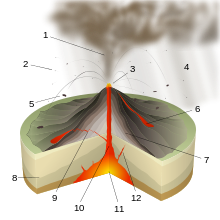
Back حجرة صهارية Arabic Vulkan ocağı Azerbaijani Cambra magmàtica Catalan Magmatický krb Czech Magmakammer Danish Magmakammer German Magma kameno Esperanto Cámara magmática Spanish Magmakamber Estonian Ganbera magmatiko Basque

A magma chamber is a large pool of liquid rock beneath the surface of the Earth. The molten rock, or magma, in such a chamber is less dense than the surrounding country rock, which produces buoyant forces on the magma that tend to drive it upwards.[1] If the magma finds a path to the surface, then the result will be a volcanic eruption; consequently, many volcanoes are situated over magma chambers.[2] These chambers are hard to detect deep within the Earth, and therefore most of those known are close to the surface, commonly between 1 km and 10 km down.[3]
- ^ Philpotts, Anthony R.; Ague, Jay J. (2009). Principles of igneous and metamorphic petrology (2nd ed.). Cambridge, UK: Cambridge University Press. pp. 28–32. ISBN 9780521880060.
- ^ "Forensic Probe of Bali's Great Volcano". Eos. 12 February 2019. Retrieved 25 November 2020.
- ^ Dahren, Börje; Troll, Valentin R.; Andersson, Ulf B.; Chadwick, Jane P.; Gardner, Màiri F.; Jaxybulatov, Kairly; Koulakov, Ivan (1 April 2012). "Magma plumbing beneath Anak Krakatau volcano, Indonesia: evidence for multiple magma storage regions". Contributions to Mineralogy and Petrology. 163 (4): 631–651. Bibcode:2012CoMP..163..631D. doi:10.1007/s00410-011-0690-8. ISSN 1432-0967. S2CID 52064179.